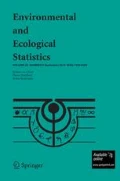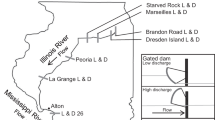Abstract
Tracking individual animals through time using mark-recapture methods is the gold standard for understanding how environmental conditions influence demographic rates, but applying such tags is often infeasible due to the difficulty of catching animals or attaching marks/tags without influencing behavior or survival. Due to the logistical challenges and emerging ethical concerns with flipper banding penguins, relatively little is known about spatial variation in demographic rates, spatial variation in demographic stochasticity, or the role that stochasticity may play in penguin population dynamics. Here we describe how adaptive importance sampling can be used to fit age-structured population models to time series of point counts. While some demographic parameters are difficult to learn through point counts alone, others can be estimated, even in the face of missing data. Here we demonstrate the application of adaptive importance sampling using two case studies, one in which we permit immigration and another permitting regime switching in reproductive success. We apply these methods to extract demographic information from several time series of observed abundance in gentoo and Adélie penguins in Antarctica. Our method is broadly applicable to time series of abundance and provides a feasible means of fitting age-structured models without marking individuals.


Similar content being viewed by others
Data Availability
All penguin time series data are available at www.penguinmap.com.
Code availability
All code is available at https://github.com/yellaham/blp.
References
Ainley D (2002) The Adélie penguin: Bellweather of change. Columbia University Press, USA
Andrieu C, Doucet A, Holenstein R (2010) Particle Markov chain Monte Carlo methods. J R Stat Soc 72(3):269–342
Besbeas P, Freeman S, Morgan B, Catchpole E (2002) Integrating mark-recapture-recovery and census data to estimate animal abundance and demographic parameters. Biometrics 58:540–547
Borboroglu P, Boersma P (2013) Penguins: Natural History and Conservation. University of Washington Press, Seattle
Bugallo MF, Elvira V, Martino L, Luengo D, Miguez J, Djuric PM (2017) Adaptive importance sampling: the past, the present, and the future. IEEE Sig Process Mag 34(4):60–79
Carter CK, Kohn R (1994) On Gibbs sampling for state space models. Biometrika 81(3):541–553
Che-Castaldo C, Jenouvrier S, Youngflesh C, Shoemaker KT, Humphries G, McDowall P, Landrum L, Holland MM, Li Y, Ji R, Lynch HJ (2017) Pan-Antarctic analysis aggregating spatial estimates of Adélie penguin abundance reveals robust dynamics despite stochastic noise. Nat Commun 8(832)
Croxall J, Kirkwood E (1979) The distribution of penguins on the Antarctic Peninsula and islands of the Scotia Sea. British Antarctic Survey
Culik B, Wilson R, Bannasch R (1993) Flipper-bands on penguins: What is the cost of a life-long commitment? Mar Ecol Prog Ser 98:209–214
Dann P, Sidhu LA, Jessop R, Renwick L, Healy M, Dettmann B, Baker B, Catchpole EA (2014) Effects of flipper bands and injected transponders on the survival of adult little penguins Eudyptula Minor. Ibis 156(1):73–83
Djuric PM, Kotecha JH, Zhang J, Huang Y, Ghirmai T, Bugallo MF, Miguez J (2003) Particle filtering. IEEE Sig Process Mag 20(5):19–38
Doucet A, Johansen A (2009) A tutorial on particle filtering and smoothing: fifteen years later. Handbook of Nonlinear Filtering 12
Doucet A, De Freitas N, Gordon N (2001) An introduction to sequential Monte Carlo methods. In: Sequential Monte Carlo Methods in Practice, Springer, pp 3–14
Dugger KM, Ainley DG, Lyver PO, Barton K, Ballard G (2010) Survival differences and the effect of environmental instability on breeding dispersal in an Adélie penguin meta-population. Proc Nat Acad Sci 107(27):12375–12380
Ghahramani Z, Hinton GE (1996) Switching state-space models. Tech. rep., King’s College Road, Toronto M5S 3H5
Gimenez O, Morgan BJ, Brooks SP (2009) Weak identifiability in models for mark-recapture-recovery data. In: Modeling Demographic Processes in Marked Populations, Springer, pp 1055–1067
Gonzales E, Martorell C, Bolker B (2016) Inverse estimation of integral projection model parameters using time series of population-level data. Meth Ecol Evol 7:147–156
Hinke J (2012) Over-winter behavior and annual survival of Pygoscelid penguins in the South Shetland Islands. PhD thesis, University of California, San Diego
Humphries G, Naveen R, Schwaller M, Che-Castaldo C, McDowall P, Schrimpf M, Lynch H (2017) Mapping Application for Penguin Populations and Projected Dynamics (MAPPPD): data and tools for dynamic management and decision support. Polar Rec 53(2):160–166
Kantas N, Doucet A, Singh SS, Maciejowski J, Chopin N (2015) On particle methods for parameter estimation in state-space models. Stat Sci 30(3):328–351
Kim C, Nelson CR (1999) State-space models with regime switching: classical and gibbs-sampling approaches with applications. MIT Press Books, USA
LaRue MA, Lynch HJ, Lyver P, Barton K, Ainley DG, Pollard AM, Ballard G (2014) Establishing a method to estimate Adélie penguin populations using remotely-sensed imagery. Polar Biol 37:507–517
Lebreton JD, Burnham K, Clobert J, Anderson D (1992) Modeling survival and testing biological hypotheses using marked animals: a unified approach with case studies. Ecol Monograph 62(1):67–118
Lescroël A, Dugger K, Ballard G, Ainley D (2009) Effects of individual quality, reproductive success and environmental variability on survival of a long-lived seabird. J Animal Ecol 78:798–806
Lynch H, Naveen R, Casanovas P (2013) Antarctic Site Inventory breeding bird survey data: 1994–2013. Ecology 94(11):2653–2653
Lynch H, Naveen R, Trathan P, Fagan W (2012a) Spatially integrated assessment reveals widespread changes in penguin populations on the antarctic peninsula. Ecology 93(6):1367–1377
Lynch HJ, White R, Black AD, Naveen R (2012b) Detection, differentiation, and abundance estimation of penguin species by high-resolution satellite imagery. Polar Biol 35:963–968
Owen A, Zhou Y (2000) Safe and effective importance sampling. J Am Statist Associat 95(449):135–143
Patterson TA, Thomas L, Wilcox C, Ovaskainen O, Matthiopoulos J (2008) State-space models of individual animal movement. Trends in Ecol Evol 23(2):87–94
Putman R (1995) Ethical considerations and animal welfare in ecological field studies. Biodiv Conservation 4(8):903–915
Robert C, Casella G (2013) Monte Carlo statistical methods. Springer Science & Business Media, Berlin
Shah K, Ballard G, Schmidt A, Schwager M (2020) Multidrone aerial surveys of penguin colonies in Antarctica. Sci Robot 5(47):eabc3000
Tokdar ST, Kass RE (2010) Importance sampling: a review. Wiley Interdisciplinary Reviews: Computational Statistics 2(1):54–60
Vehtari A, Simpson D, Gelman A, Yao Y, Gabry J (2021) Pareto smoothed importance sampling
Williams BK, Nichols JD, Conroy MJ (2002) Analysis and management of animal populations. Academic Press, Cambridge
Woehler E, Croxall JP (1997) The status and trends of antarctic and sub-antarctic seabirds. Mar Ornithol 25:43–66
Acknowledgements
The authors would like to thank Stony Brook University’s OVPR seed award program for funding, and the Institute for Advanced Computational Sciences for high-performance computing support.
Funding
The authors would like to thank Stony Brook University’s OVPR seed award program for funding, and the Institute for Advanced Computational Sciences for high-performance computing support.
Author information
Authors and Affiliations
Contributions
El-Laham led the code development in consultation with Bugallo, and Lynch led the data collection and the ecological interpretation of the results. All authors contributed to the study design and manuscript preparation.
Corresponding author
Ethics declarations
Conflicts of interest/Competing interests
Not applicable.
Additional information
Communicated by Luiz Duczmal.
Supplementary Information
Below is the link to the electronic supplementary material.
Rights and permissions
About this article
Cite this article
El-Laham, Y., Bugallo, M. & Lynch, H.J. Switching state-space models for modeling penguin population dynamics. Environ Ecol Stat 29, 607–624 (2022). https://doi.org/10.1007/s10651-022-00538-3
Received:
Revised:
Accepted:
Published:
Issue Date:
DOI: https://doi.org/10.1007/s10651-022-00538-3




